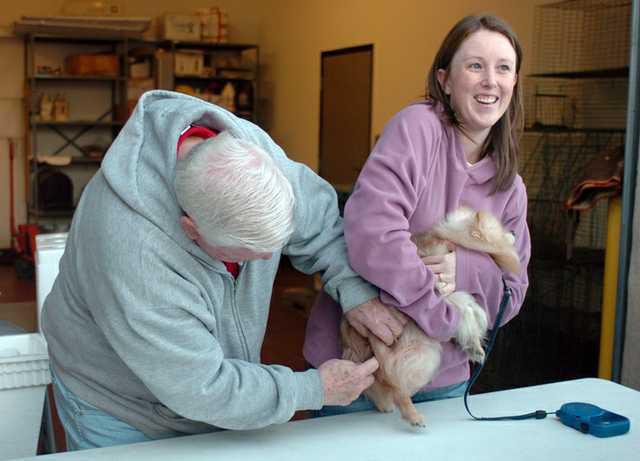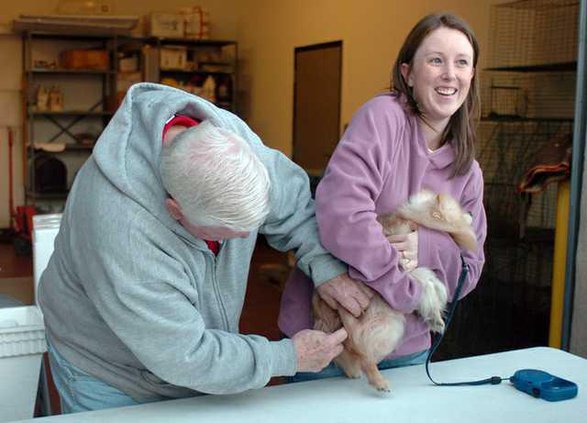0404rabiesaud
Listen as DNR wildlife biologist Scott Frazier explains why you should avoid contact with wild animals.Experts are at a loss to explain why the incidence of rabies seems to be so high in Hall County.
In the first three months of 2008, there were 15 confirmed cases in wild animals, all but two of which occurred in March.
Normally, Hall has about six to eight reported cases in an entire year.
It’s not unusual for rabies cases to increase in the spring, when animals become more active. But Scott Frazier, a wildlife biologist with the Georgia Department of Natural Resources in Gainesville, said he doesn’t know why the seasonal spike in cases is so much higher this year.
The size and density of wildlife populations in the area doesn’t seem to have changed, he said. "We don’t have any indication that there are exceedingly high numbers of raccoons and skunks in Hall County."
The majority of cases this year have been in skunks and raccoons, and most were found in North Hall.
Frazier speculated that the "epidemic" may be feeding on itself.
"Some of this may be driven by media coverage," he said. "People are calling (DNR) when they see a skunk. The more aware they are, the more complaints you’re going to get, and the more animals will be tested (for rabies)."
Frazier said Georgians have been co-existing with the rabies virus for a long time. "Rabies is naturally occurring in Georgia," he said. "It’s been endemic to the Southeast, because it’s more common in warm, humid areas."
The virus causes a fatal neurological illness that can affect any mammalian animal, including humans. But certain species are known to be carriers. In the United States, the ones to watch out for are raccoons, skunks, coyotes, foxes and bats.
"Our approach is to treat those animals as if they’ve all got rabies," Frazier said. "Don’t touch it; don’t let your pets go near it; don’t encourage it to approach you."
But the mere presence of a raccoon is no reason to panic. "Simply seeing one of these animals does not require you to call anybody," he said. "If it is behaving abnormally (but no one has touched it), it’s worth calling (DNR). If there’s been contact with a pet, call animal control, or with a person, call the health department."
Frazier said our society has become so urbanized that many people have no experience with wildlife, and they don’t know what "abnormal" behavior looks like.
"Probably the most common call we get about rabies is an animal being active during the daytime," he said. "That is not necessarily a sign of rabies. In the spring, animals have young to take care of, and they may be up and about at any time of day."
A better indicator, Frazier said, is whether the animal seems disoriented.
"We ask people, ‘Does the animal appear to have a purpose? Does it seem to be going somewhere, or is it just wandering back and forth or maybe just going in a circle, or even standing still?’"
In the later stages of rabies, the animal may become aggressive.
"There was a case last year near Wilshire Trails where a fox chased a pet," Frazier said. "The owner brought the pet into the house, and then the fox attacked the door and tried to bite off the handle."
But he said sudden, violent attacks are rare, and they can’t be predicted or prevented.
"The ones we worry about are when people intentionally put themselves in harm’s way," he said. "They see an animal that looks sick and they try to help it."
Cail Collins, deputy director of environmental health for District 2 Public Health in Gainesville, said nonprofessionals should not risk touching a sick animal, because the consequences are potentially deadly.
"Rabies is fatal if not treated," he said. "You can get a series of preventative shots right after the bite. But if you’re bitten by a proven rabid animal and you’ve already started showing symptoms, there’s no treatment at that point."
Collins said once someone becomes ill with rabies, they usually succumb within about 10 days.
"There’s fever and headaches at first, progressing to paralysis of the smooth muscles, especially in the throat, which prevents swallowing," he said. "Eventually it leads to coma and death."
The last case of human rabies in Georgia occurred in October 2000, when a 26-year-old Taylor County man died after he was bitten by a bat while sleeping.
Bats are the most common "vector" species for human rabies in the U.S. But in Third World countries, rabies is most often transmitted by domestic dogs.
"In the U.S., there’s usually only two or three human cases a year," said Collins. "In developing nations, it’s a different story because the dogs aren’t vaccinated."
Frazier said widespread vaccination of dogs and cats has almost wiped out rabies among humans in the U.S.
"Our current system is fairly effective at breaking the chain between the wildlife vector and people," he said.
But that system isn’t perfect, as a recent case demonstrates.
Most of the counties surrounding Hall have not reported any rabies cases this year. Dave Palmer, spokesman for District 2 Public Health, said Habersham has had one case, in a raccoon. And Banks has had two, in a skunk and a domestic dog.
The latter incident is extraordinary, according to Rick Aiken, president of the Humane Society of Hall County.
"I don’t recall ever seeing a case in a dog here," he said.
Palmer said in the Banks case, an unvaccinated dog apparently encountered a raccoon and was put into quarantine, as state law requires. The dog developed rabies during its confinement and died.
That’s disconcerting news to people who handle animals for a living. The travel clinic at the Hall County Health Department offers a "pre-exposure" rabies vaccine for people, mainly intended for veterinarians, wildlife biologists and others in high-risk jobs.
But it’s pricey. "Each shot is $176 plus a $15 administrative fee, and you need three shots in 30 days, so that’s almost $600," said Palmer.
Aiken said the animal shelter staff is currently not vaccinated against rabies, because of the expense.
"But given the current situation, we may have to look at that," he said.
Right now, the Humane Society is focused on vaccinating pets. The organization offered a low-cost rabies clinic March 22, and more than 400 dogs and cats were vaccinated within about three hours. But that didn’t begin to meet the need.
"So many people came to our last clinic and we had them backed up all the way to the (QuikTrip) station (at West Ridge and U.S. 129)," Aiken said.
The society has scheduled another clinic at the shelter from 8:30 a.m. to noon April 19. "This time we’ll have two veterinarians instead of one, which should tremendously speed it up," Aiken said.
The shots, for dogs and cats at least 3 months old, cost $10 each. All animals must be on leashes or in carriers.
Aside from getting pets vaccinated, Frazier said people can protect themselves against rabies by making their property less attractive to wildlife.
"Ultimately the best rule of thumb is to never leave food outside, especially pet food," he said.
Frazier said parents also need to teach their children not to approach wildlife.
"If you happen to see an animal out in the wild, that’s the ideal time for a parent to remind the child never to go near it," he said. "They’ll remember your advice better when they’re actually looking at an animal."




